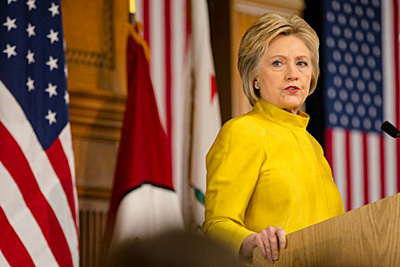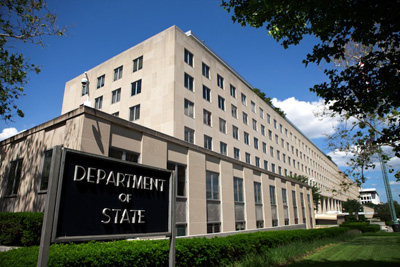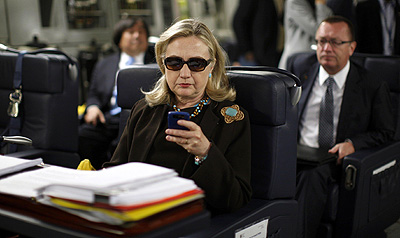Have you read the entire FBI report on the agency’s investigation into Hillary Clinton’s email practices? No? Well, I have, because that’s the kind of professional I am. And I’m going to provide you with all the most interesting excerpts.
The report starts off with a whole bunch of technical detail about how the Clinton email server was set up and managed, and is basically uninteresting except to nerds. As everyone knows, Hillary’s email was originally hosted on a  personal server in her home (referred to as the “Pagliano Server”) and was later transferred to a commercial hosting service, Platte River Networks (the “PRN Server”). We’ll pick up the action on page 7:
personal server in her home (referred to as the “Pagliano Server”) and was later transferred to a commercial hosting service, Platte River Networks (the “PRN Server”). We’ll pick up the action on page 7:
Page 7: At the time of the FBI’s acquisition of the Pagliano Server, Williams & Connolly did not advise the US Government […] that Clinton’s clintonemail.com e-mails had been migrated to the successor PRN Server remaining at Equinix. The FBI’s subsequent investigation identified this additional equipment and revealed the e-mail migration.
This strikes me as bad. Hillary’s lawyers gave the FBI the old Pagliano Server when they asked for it, but didn’t tell them that everything had been migrated to PRN. Why not?
Page 8: [Huma] Abedin recalled that at the start of Clinton’s tenure, State advised personal e-mail accounts could not be linked to State mobile devices and, as a result, Clinton decided to use a personal device in order to avoid carrying multiple devices.
In other words, Hillary could get a State-approved device but couldn’t receive her personal email on it. Likewise, she could use a personal device, but couldn’t get State email on it. The only way to get both was to carry two physical devices. She considered this inconvenient, and decided to keep on using her personal BlackBerry for everything. This is exactly what she’s been saying all along.
Page 8: FBI investigation identified 13 total mobile devices […] which potentially were used to send e-mails […] eight of which she used during her tenure as Secretary of State.
This has become a big talking point on the right for some reason. Hillary didn’t have one device for convenience, she had 13! This is ridiculous. Over time, she had 13 devices, but the report makes it clear that she always had just one device at a time.
Page 9: According to Abedin, it was not uncommon for Clinton to use a new BlackBerry for a few days and then immediately switch it out for an older version with which she was more familiar. Clinton states that when her BlackBerry device malfunctioned, her aides would assist her in obtaining a new BlackBerry, and, after moving to a new device, her old SIM cards were disposed of by her aides.
I’m only including this because, WTF? How often did Hillary’s BlackBerries malfunction? If she had eight in four years, it means they each lasted about six months. Why were they so fragile? Did they just buy a new BlackBerry every time there was some kind of bug they couldn’t figure out how to resolve?
Page 11: On January 23, 2009, Clinton contacted former Secretary of State Colin Powell via e-mail to inquire about his use of a BlackBerry while he was Secretary of State (January 2001 to January 2005). In his e-mail reply, Powell warned Clinton that if it became “public” that Clinton had a BlackBerry, and she used it to “do business,” her e-mails could become “official record[s] and subject to the law.” Powell further advised Clinton, “Be very careful. I got around it all by not saying much and not using systems that captured the data.”
This is important. First, it makes clear that Hillary conversed with Colin Powell two days after becoming secretary of state, not “a year later,” as Powell has claimed. Second, Powell essentially told her that he had just gone ahead and broken the law by “not using systems that captured the data.” Hillary, by contrast, chose instead to retain everything as the law required.
Page 11: While State policy during Clinton’s tenure required that “day-to-day operations [at State] be conducted on [an authorized information system],” according to the REDACTED the Bureau of Information Security Management, REDACTED there was no restriction on the use of personal e-mail accounts for official business. […] In 2011, a notice to all State employees was sent on Clinton’s behalf, which recommended employees avoid conducting State business from personal e-mail accounts due to information security concerns.
This makes it clear that although State “recommended” that employees not use personal accounts, there was no rule prohibiting it. And apparently personal accounts were very widely used.
Page 12: State Diplomatic Security Service (DS) instructed Clinton that because her office was in a SCIF, the use of mobile devices in her office was prohibited. Interviews of three former DS agents revealed Clinton stored her personal BlackBerry in a desk drawer in DS “Post 1,” which was located within  the SCIF on Mahogany Row. State personnel were not authorized to bring their mobile devices into Post 1, as it was located within the SCIF.
the SCIF on Mahogany Row. State personnel were not authorized to bring their mobile devices into Post 1, as it was located within the SCIF.
I’m only including this because it’s gotten some attention on the right. This paragraph says Hillary always checked in her BlackBerry when she came into the office, as she was required to do, but checked it into Post 1. Apparently this was the wrong thing to do. But if it was, surely this is the fault of DS, not Hillary, who plainly had no incentive to store her BlackBerry in the wrong place.
Page 13: Thirteen individuals, consisting of State senior-level employees, work-related advisors, and State executive administrative staff, maintained direct e-mail contact with Clinton.
That’s not very many. It’s not as if potentially sensitive information was flying around to hundreds of people.
Page 14: Heather Samuelson, an attorney working with [Cheryl] Mills, undertook a review to identify work-related e-mails, while Kendall and Mills oversaw the process. […] Clinton was not consulted on specific e-mails in order to determine if they were work-related.
This is how Hillary’s work-related emails were separated from her personal emails after State asked for them. It’s only relevant because it makes clear that Hillary herself had no input into the selection process. She just gave the order to produce the emails requested by State. Apparently she wasn’t very concerned that there would be anything embarrassing in there.
This is nothing new. FBI Director James Comey said as much months ago about emails the FBI had recovered: “We found no evidence that any of the additional work-related e-mails were intentionally deleted in an effort to conceal them. Our assessment is that, like many e-mail users, Secretary Clinton periodically deleted e-mails or e-mails were purged from the system when devices were changed. Because she was not using a government account—or even a commercial account like Gmail—there was no archiving at all of her e-mails, so it is not surprising that we discovered e-mails that were not on Secretary Clinton’s system in 2014, when she produced the 30,000 e-mails to the State Department.”
Pages 18-19: According to Mills, in December 2014, Clinton decided she no longer needed access to any of her e-mails older than 60 days. […] On March 2, 2015, The New York Times (NYT) published an article titled “Hillary Clinton Used Personal Email Account at State Dept., Possibly Breaking Rules.” […] In his interviews with the FBI, REDACTED [a PRN techie] indicated that sometime between March 25-31, 2015, he realized he did not make the e-mail retention policy changes to Clinton’s clintonemail.com e-mail account that Mills had requested in December 2014. […] He believed he had an “oh shit” moment and sometime between March 25-31, 2015 deleted the Clinton archive mailbox from the PRN server and used BleachBit to delete the exported .PST files he had created on the server system containing Clinton’s e-mails.
This explains why data was removed from the PRN server after the New York Times article and after the Benghazi committee had subpoenaed Hillary’s emails. It had nothing to do with anyone around Hillary Clinton. An IT guy at PRN realized one day that he’d forgotten about the retention order and went ahead and implemented it.
The report makes clear that Cheryl Mills sent an email, which the PRN techie received, telling PRN about the preservation request from the Benghazi committee. The techie said he knew it meant he shouldn’t disturb the Clinton server but apparently got confused and didn’t realize this meant he shouldn’t touch the old archives or the backups.
Page 20: When asked of her knowledge regarding TOP SECRET, SECRET, and CONFIDENTIAL classification levels of USG information, Clinton responded that she did not pay attention to the “level” of classification and took all classified information seriously.
For some reason there are people guffawing at this, but I don’t know why. The plainest reading is not that Hillary had no idea what various classification levels meant, but that she treated all classified information seriously no matter what level it was at.
Page 22: The FBI interviewed multiple officials who authored and/or contributed to e-mails, the content of which has since been determined to contain classified information. USG employees responsible for initiating classified e-mail chains include State Civil Service employees, Foreign Service employees, Senior Executive Service employees, Presidential employees, and non-State elected officials.
I can’t quite tell if the report suggests that every classified email they recovered was initiated by someone else, but it seems like it. Basically, other people sent stuff to Hillary, and she trusted that these folks knew what they were doing. She didn’t initiate any email exchanges herself that included classified information.
Page 23: During FBI interviews, State employees explained the context for why classified material REDACTED was sent and provided reasons to explain why they did not believe information in the e-mails was classified. […] Authors of the e-mails stated that they used their best judgment in drafting the messages and that it was common  practice at State to carefully word e-mails on UNCLASSIFIED networks so as to avoid sensitive details or “talk around” REDACTED classified information.
practice at State to carefully word e-mails on UNCLASSIFIED networks so as to avoid sensitive details or “talk around” REDACTED classified information.
This whole section is a description of common practices at State. Basically, most people the FBI talked to used private email accounts all the time; did their best to keep classified information out of these channels; and didn’t believe that any of the emails they sent included classified information. Other classification authorities have disagreed, as we all know by now, and the entire discussion gives you a taste of how subjective the classification process is. Basically, we have lots of experienced people who disagree about whether various things really ought to be classified.
Page 25: On the morning of June 17, 2011, Clinton asked [Jake] Sullivan to check on the status of talking points she was supposed to have received. Sullivan responded that the secure fax was malfunctioning but was in the process of being fixed. Clinton instructed Sullivan that if the secure fax could not be fixed, he should “turn [the talking points] into nonpaper [with] no identifying heading and send nonsecure.” State uses the term “non-paper” to refer to a document which is authorized for distribution to a foreign government wihout explicit attribution to the U.S. government and without classified information.
This provides an explanation for the “nonpaper” thing that got so much attention on Fox News a while back. It’s nothing nefarious. It’s standard jargon at the State Department for turning a classified document into an unclassified document and removing all the headers. This incident shows not negligence, but a rather strict adherence to the rules.
Page 27: FBI investigation and forensic analysis did not find evidence confirming that Clinton e-mail server systems were compromised by cyber means.
This section goes on for pages and pages, but this is really the only sentence you need. It could be that Hillary’s email server was hacked. Anything is possible. But despite tons of forensic analysis, the FBI found no evidence of it. This doesn’t mean that Hillary should have used a private server, and it doesn’t mean her server used best security practices. She shouldn’t have, and it didn’t. Nonetheless, there’s no reason to think her server was ever hacked other than “don’t be an idiot, of course it was.”
Oddly, the FBI never really addresses the issue of whether Hillary violated federal record retention rules. They obviously believe that she should have used a State email account for work-related business, but that’s about it. I suppose they decided it was a non-issue because Hillary did, in fact, retain all her emails and did, in fact, turn them over quickly when State requested them.
There’s also virtually no discussion of FOIA. What little there is suggests that Hillary’s only concern was that her personal emails not be subjected to FOIA simply because they were held on the same server as her work emails.
If you read the entire report, you’ll find bits and pieces that might show poor judgment on Hillary’s part. The initial decision to use one email device is the obvious one, something that Hillary has acknowledged repeatedly. Another—maybe—is her staff’s view of what was safe to send over unclassified email. But this is very fuzzy. It could be that her staff knew exactly what it was doing, and it’s the subsequent classification authorities who are wrong. This is something that it’s impossible to judge since none of us will ever see the emails in question.
That said, this report is pretty much an almost complete exoneration of Hillary Clinton. She wasn’t prohibited from using a personal device or a personal email account, and others at state did it routinely. She’s told the truth all along about why she did it. Colin Powell did indeed advise her about using personal email shortly after she took office, but she chose to follow the rules rather than skirt them, as Powell did. She didn’t take her BlackBerry into her office. She communicated with only a very select group of 13 people. She took no part in deciding which emails were personal before handing them over to State. She had nothing to do with erasing information on the PRN server. That was a screw-up on PRN’s end. She and her staff all believed at the time that they were careful not to conduct sensitive conversations over unclassified email systems. And there’s no evidence that her server was ever hacked.
There’s remarkably little here. If you nonetheless believe that it’s enough to disqualify Hillary from the presidency, that’s fine. I have no quarrel with you. But if the FBI is to be believed, it’s all pretty small beer.

















